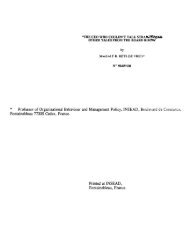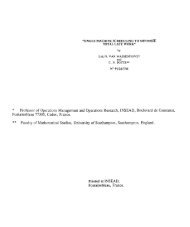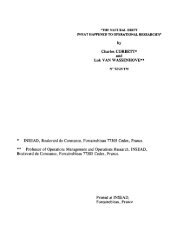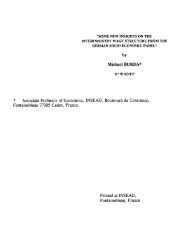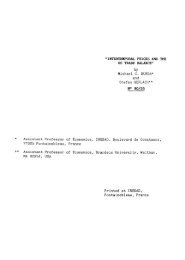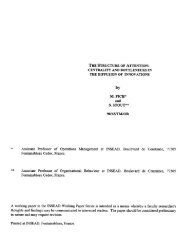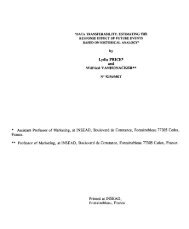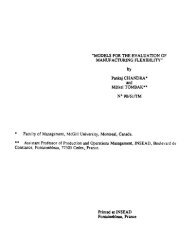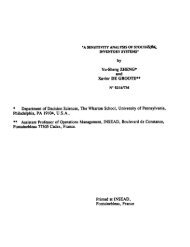* Assistant Professor of Operations Management at INSEAD ...
* Assistant Professor of Operations Management at INSEAD ...
* Assistant Professor of Operations Management at INSEAD ...
Create successful ePaper yourself
Turn your PDF publications into a flip-book with our unique Google optimized e-Paper software.
This condition will usually not be fulfilled. If it is not fulfilled, then there<br />
is no customer differenti<strong>at</strong>ing equilibrium, because the firms have no way<br />
to distinguish the customers other than direct type identific<strong>at</strong>ion. Such a<br />
situ<strong>at</strong>ion is demonstr<strong>at</strong>ed in the following example.<br />
The market consists <strong>of</strong> 2 segments, with a high priority segment A and a<br />
low priority segment B. The groups are characterized by cA = 2 and pA = 5,<br />
whereas cB = 3 and fiB = 3. Thus cApA = 10 > 9 = cE4.43. Th<strong>at</strong> is, group A<br />
has the higher imp<strong>at</strong>ience-to-service time r<strong>at</strong>io, even though group B has a<br />
higher waiting cost r<strong>at</strong>e and is thus more imp<strong>at</strong>ient in the usual sense <strong>of</strong> the<br />
word. 2 The demand functions are PA(AA) = 1—A A and PB(AB) = 10-10AB.<br />
Thus, both groups are <strong>of</strong> the same size, but group B is more price sensitive<br />
and toler<strong>at</strong>es a higher maximum full price <strong>of</strong> 10.<br />
We insert these numbers into the formulae for the average delay and into<br />
the FOC, equ<strong>at</strong>ions (2), and we solve the FOC numerically. We find th<strong>at</strong><br />
in equilibrium each firm produces volumes <strong>of</strong> AA = 0.149 and AB = 0.292.<br />
These volumes result in prices <strong>of</strong> pA = 0.222 and pB = 3.015 and in delays<br />
<strong>of</strong> WA = 0.239 and WB = 0.379. The incentive comp<strong>at</strong>ibility condition<br />
requires th<strong>at</strong> pA > pB . However, type B customers end up paying more for<br />
inferior service! If the firms cannot identify customers upon placement <strong>of</strong> an<br />
order, type B customers see the chance <strong>of</strong> switching to lower price and faster<br />
delivery by lying about their type and subscribing as type A customers. The<br />
equilibrium breaks down. The market is unable to produce prices th<strong>at</strong> clear<br />
the quantities <strong>of</strong>fered by the two firms (who engage in quantity competition).<br />
Before I propose a contract th<strong>at</strong> restores the equilibrium, some remarks<br />
should illumin<strong>at</strong>e the circumstances under which it can occur th<strong>at</strong> the linear<br />
prices emerging from a full-inform<strong>at</strong>ion equilibrium are not incentive comp<strong>at</strong>ible.<br />
Inspection <strong>of</strong> the incentive-comp<strong>at</strong>ibility condition (4) reveals two<br />
types <strong>of</strong> situ<strong>at</strong>ions leading to incentive problems:<br />
1. The r<strong>at</strong>io c„ p„ is very high in comparison to some other type's cmitm<br />
because p 7, pm. In this case, the delivery time for m customers is<br />
very large by the sheer size <strong>of</strong> the raw service time, and this is not<br />
compens<strong>at</strong>ed for by a small waiting cost. Even though the cash price<br />
pm is not too large, the full price Pm is mainly driven by the waiting<br />
cost component and produces an incentive for type m customers to lie.<br />
2 Recall th<strong>at</strong> both firms have the same capacities, so the service r<strong>at</strong>es named above hold<br />
<strong>at</strong> both firms.<br />
11



